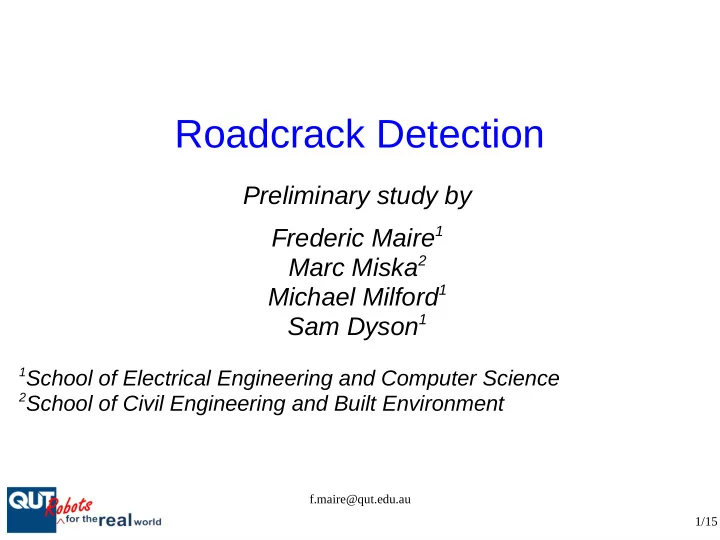

Roadcrack Detection Preliminary study by Frederic Maire 1 Marc Miska 2 Michael Milford 1 Sam Dyson 1 1 School of Electrical Engineering and Computer Science 2 School of Civil Engineering and Built Environment f.maire@qut.edu.au 1/15
Research Environment “Robotics and Autonomous Systems” Semantic Vision creating new learning algorithms to detect and recognise objects and places Vision & Action creating new theory for linking visual percepts and action, for navigation, grasping and human collaboration Robust Vision creating new sensors and robust algorithms to enable operation in real-world situations Algorithms & Architectures creating novel technologies and techniques for computing and communicating. www.roboticvision. ARC Centre of Excellence for Robotic Vision org
First attempt https://www.youtube.com/watch?v=_jIp_kbOB6s www.roboticvision. ARC Centre of Excellence for Robotic Vision org
Road crack detection with CUDA ● We have developed a highly discriminative algorithm ● Slow on CPU (~ 1 frame per minute) ● Speed up with CUDA (GPU computing) implementation on a graphics card 3D plot crack detector
Projective transformation gives a bird eye view of the road
Why is roadcrack detection difficult?
clicked at (581,362) hist values 0.0 0.0 0.0 0.0 0.0 0.0 0.57 0.43 0.0 0.0 0.0 - - - - - - - - - - - - - - - - - - - - min 6.2 , max 7.7 , (max-min)/avg 0.21 (max-min)/max 0.19
hist values 0.0 0.0 0.0 0.0 0.0 0.011 0.17 0.81 0.011 0.0 0.0 - - - - - - - - - - - - - - - - - - - - min 5.9 , max 8.0 , (max-min)/avg 0.3 (max-min)/max 0.27
clicked at (413,221) hist values 0.0 0.0 0.0 0.0 0.0 0.0 0.0 0.3 0.7 0.0 0.0 - - - - - - - - - - - - - - - - - - - - min 7.5 , max 8.8 , (max-min)/avg 0.16 (max-min)/max 0.15
clicked at (659,243) hist values 0.0 0.0 0.0 0.0 0.0 0.0 0.0 0.95 0.045 0.0 0.0 - - - - - - - - - - - - - - - - - - - - min 7.1 , max 8.1 , (max-min)/avg 0.13 (max-min)/max 0.12
Technical challenges ● Evaluating the “ring distance histogram” for each pixel is computationally expensive ● Possible approaches – Use a pre-processing step with adaptive thresholding and morphological operations to produce a reduced number of candidate roadcrack pixels – Collect training data, label it using the computationally expensive algorithm, and train a deep neural network to classify the pixels of new images f.maire@qut.edu.au 11/15
Deep neural networks ● Standard Convolutional Neural Networks f.maire@qut.edu.au 12/15
Conversion of a classification net into output a heatmap f.maire@qut.edu.au 13/15
Conclusion ● Roadcrack detection is a low-hanging fruit! f.maire@qut.edu.au 14/15
15/15
Recommend
More recommend